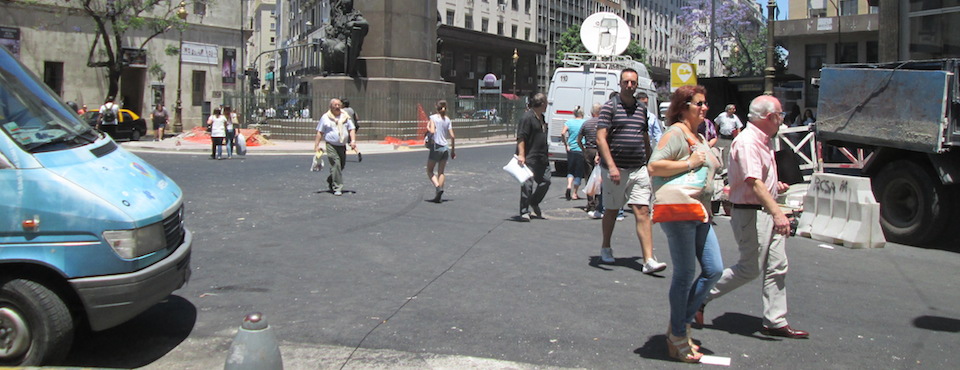Buenos Aires a commencé il y a quelques années à prendre des mesures pour les piétons, avec des rues de l’hypercentre (microcentro) qui ont été coupées au trafic ou où il a été réduit (réaménagement, vitesse limite 10 km/h, déplacement des itinéraires bus – voir quelques illustrations sur le site de la ville), des mesures d’accessibilité pour les handicapés et des interventions sur les carrefours pour les réduire, “à la new-yorkaise”: peinture, potelets, bacs de fleurs, bref aménagements bon marché mais qui donnent plus d’espace aux pétons, raccourcissent les traversées et clarifient la situation.
Un plan de mesures assez pragmatique et ambitieux, qui n’a pas peur de réduire les gabarits routiers pour concrétiser la vision des priorités dans le centre.
Dans ce post je voulais parler de la place à l’intersection de l’avenue Roca (Diagonal Sur) et de la rue Perú, où les travaux de réaménagement ont commencé. On observe des traversées sur toute la place, et en particularité une ligne de désir dans la continuité de la rue Perú, rejoignant les quartiers de Montserrat et San Telmo (résidentiel + activités) à l’hypercentre qui concentre une partie importante des emplois + des commerces et activités.
L’idée du projet est de simplifier le fonctionnement, d’augmenter les espaces dédiés aux piétons et de rendre les traversées plus visibles. Il est très légitime et approprié, même si à mon sens il contourne un problème majeur: la statue du président Roca et ses grillages, qui occupent le milieu de la place et coupent la continuité de la rue Perú, physiquement et visuellement. Il faut ajouter que cette statue est celle d’un président controversé, connu surtout pour avoir conquis la Patagonie en exterminant quasi systématiquement les indigènes qui y vivaient. A mon avis donc, l’aménagement aurait été complet en enlevant la statue et en établissement une vraie continuité Nord-Sud.
- Schéma de la position de l’intervention. Bâtiments publics en gris, rues à trafic interdit / restreint en bleu, secteur de haute densité d’emplois (schéma) en orange
- Vue depuis le Nord de la place (rue Perú)
- Ligne de désir schématisée – continuité de la rue Perú
- Vue depuis le Nord, direction Sud-Est
- Embranchement Sud de la rue Perú
- Vue depuis le Sud (rue Perú)
- Vue depuis le Sud, direction Nord-Ouest
- Au Sud: préparation des travaux, une voie a été supprimée pour élargir le trottoir
- Embranchement Nord de la rue Perú
- Image de synthèse du projet, source: ville de Buenos Aires
This post is also available in: French












